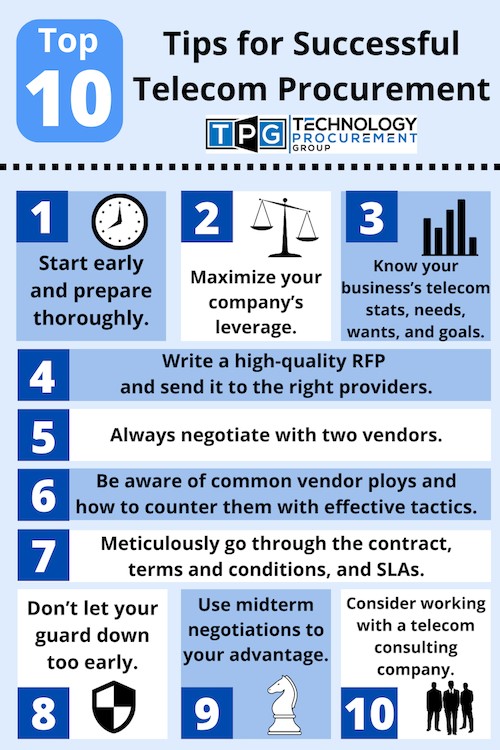Telecom procurement can be a challenging process, even when you have a great procurement team and strategy in place. Here are our top ten telecom procurement strategy consulting tips for maximum success.
Defining clear objectives is the foundational step in crafting a successful telecom procurement strategy. Organizations must articulate their goals, whether it be cost optimization, enhanced service quality, or improved scalability.
Table of Contents

Curious about refining your telecom procurement strategy? Uncover valuable insights in our comprehensive guide.
1. Start early and prepare thoroughly.
One of the most crucial things you can do to ensure your business’s success in procuring telecom services is to start early and find a great consulting organization to walk along side of your team. Beginning the process nine to 12 months before your current contract ends will give you plenty of time to move through all of the steps of procurement without having to rush and increase stress for yourself and your procurement team.
Not only will you need time to prepare for the telecom procurement process (more on that below), but it takes time to compose an RFP and select the vendors you want to send it to. After sending the RFP, you’ll need to have sufficient time to wait for vendors’ proposals.

Once you’ve received them, it’s smart to schedule meetings and demonstrations with your top choices to get a better feel for the solutions they’re offering. Then, it’ll be time to negotiate and fine-tune the contract before signing, which can be a lengthy process.
Here are a few of the negative consequences that can occur when businesses fail to allow nine months to a year for procurement:
- They lose their leverage, which is vital to procurement success
- They’re stuck with their current provider for another three years, even if they aren’t satisfied with its service
- They sign a contract without taking the necessary time to redline and negotiate the terms, which can be very risky
- They miss out on excellent providers who can offer innovative solutions and cost savings because they don’t have the time to evaluate their options and negotiate
- They prevent true competition; vendors will look at the timeline and know there isn’t enough time for them to implement their solutions, so they won’t bid
- The incumbent provider loses the incentive to lower its rates because it knows the business doesn’t have enough time to migrate its services to another vendor
Now, onto preparation. Preparing for procurement includes a variety of steps, including the following:
- Learning about relevant concepts, such as change management, the DIKW Model, the General Data Protection Regulation, and how to maximize leverage
- Utilizing financial models and cost transparency to evaluate how your company will be affected by various vendor and service choices
- Putting together a procurement team and establishing communication within the team
- Familiarizing the team with your company’s data, previous RFPs, and existing contracts
Thorough preparation that begins well before your business’s current contract ends is the best way to increase your odds of procurement success from the start.
2. Maximize your company’s leverage.

Maximizing your leverage is another important way to make sure your company’s procurement process is successful.
Leverage, in short, is power and influence. When a company has leverage, it has power over vendors that it can use to its advantage. Of course, this goes the other way, too–vendors can have leverage and power over potential clients. That’s why it’s essential to do what you can to maximize your leverage.
Here are six ways to increase your organization’s leverage during procurement:
- When you say something to a vendor, always follow through on it. Show that when you say something, you mean it.
- Have a company history of conducting RFPs and moving your business so that vendors can see that you’re serious about negotiating and finding the services and terms that most benefit you.
- Have low existing commitments with your current provider.
- As mentioned in Tip #1, give your business enough time to go through the procurement process rather than rushing it.
- Create competition between vendors to give your company more power and influence pricing downward.
- Do research on your potential vendors and gain as much knowledge about them as possible, especially regarding their sales incentives, so that you know what motivates them and how they’re compensated.
There are many factors that you may think give your company leverage that, in reality, don’t make a very large impact. For example, your company’s size, need for savings, high commitments, and long-term contracts don’t have much of a positive effect on leverage. Similarly, establishing deadlines and having strategic relationships with your current providers aren’t great for leverage, either.
3. Know your business’s telecom stats, needs, wants, and goals.

Having a clear and detailed understanding of your company’s telecom statistics, needs, wants, and goals is another significant contributor to procurement success.
Statistics
Your procurement team should be familiar with all of your company’s telecom data, including inventory and the amount of traffic transmitted over your networks.
Look through your internal traffic reports, carrier management portals, business databases, spreadsheets, telecom expense management software, bill copies, and other inventory management tools to find these numbers.
Not only do you need to know your current figures, but you’ll also want to know how much bandwidth your company needs and where it’s projected to go over the next three years (the typical length of a telecom contract term).
When you know your company’s stats and data, you can avoid using overinflated vendor estimates that can lead to you paying far more than you need to for telecom services.
Needs and Wants
Your team should also know exactly what the business requires and expects from vendors. This includes:
- Specific products, services, and features
- Your company’s budget and how much it’s willing to spend on telecom (yearly audits are helpful here)
- Expectations for customer service and support
- Current pain points that need to be addressed
- Desired contract terms and SLAs (Service Level Agreements)
It’s also a good idea to have company stakeholders create vendor-specific wishlists covering their desired contract terms and conditions, service levels, and technology features.
Goals
Your company’s short-term and long-term goals and overall roadmap for the future go hand in hand. In addition, the procurement team should look at anticipated technology changes over the next few years and discuss how they might impact your company and how they can be leveraged during procurement.
Having a digital transformation strategy in place, along with future plans, is a great way to be prepared and support your organization’s goals. It’s also good to know about the level of growth the company is projected to experience and how that will affect its need for scalability of telecom services and customer support.
4. Write a high-quality telecom RFP and send it to the right providers.

Choosing RFP Recipients
When selecting RFP recipients, the best move is to send RFPs to potential service providers that seem the most promising. These should be just a handful of vendors who are likely to provide the highest-quality proposals.
Smaller, less complex projects should have fewer RFP recipients, while larger, more involved projects may warrant more RFP recipients.
Avoid the frequent mistake of casting a wide net. Although you may think that sending your company’s telecom RFP to as many vendors as possible is beneficial because it’ll give you plenty of options and create an air of competition that will push each vendor to offer a better deal, it’s counterproductive in several ways.
The idea of receiving tons of proposals and being able to pick and choose the best ones may seem appealing in theory, but in practice, it takes a lot of time and energy to thoroughly evaluate each and every proposal you receive. Sending out RFPs costs your business time and money, and composing proposals costs the vendors time and money.
In addition, repeatedly sending RFPs to vendors and then failing to work with them can lead to vendor burnout. Vendors will stop sending you proposals if they don’t think they have a good chance of winning your business.
Plus, sending out too many RFPs decreases your leverage–and as we’ve discussed, leverage is vital to procurement success. When you send RFPs to nearly every vendor in the area, it gives off the impression that your business doesn’t know what it wants and doesn’t follow through.
Before you send your RFPs, it’s wise to send out non-disclosure agreements to potential vendors as well.
Can’t Narrow Down Potential Vendors?
If you have a long list of potential vendors and no idea which ones are the most promising, consider sending out telecom RFIs, or Requests for Information. These brief documents are simpler to put together than RFPs, and they’re quicker to respond to for vendors. They’ll provide you with the industry and vendor information you need to move on and send out your RFPs.
Another option to help you narrow down your list of potential RFP recipients is to hold pre-RFP meetings. During these meetings, your procurement team will get the chance to ask plenty of questions about vendors’ product and service offerings and differentiators from their competition. This is highly recommended by TPG based on our years of experience.
Telecom RFP Basics
An RFP is a Request for Proposal. An effective and well-written RFP can be the difference between getting the telecom solution your business needs as well as ending up with services that fall flat.
Here are a few tips for writing a high-quality RFP:
- Know your company’s current telecom state, as well as its telecom needs and goals for the next few years.
- Pay special attention to the “Telecom Requirements” section. This is the most important section of the RFP and needs to clearly state exactly what your company is looking for.
- Include your selection criteria for telecom vendors so that they know how their proposals will be evaluated.
- Don’t forget to include contact information for members of your procurement team so that potential vendors can ask questions and get in contact as needed.
- Attach various spreadsheets covering your telecom inventory, taxes, and regulatory fees, as well as network Visio diagrams with confidential information excluded. This will help vendors get a better feel for your telecom needs. Be sure to lock your spreadsheets so that vendors cannot modify them.
- Include your business’s contract template with the RFP.
- Consider using RFP software or setting up an online database to automate the RFP and proposal process.
- Give vendors 30 days to respond with their proposals.
5. Always negotiate with two vendors.

After you receive vendors’ proposals in response to your RFP, you may want to choose one and begin negotiating. This is a huge mistake! To maintain leverage, you should always work with two vendors.
If a vendor knows that you’ve selected it as the winner of the contract, it’s not going to be willing to amend its terms and conditions or reduce pricing–it already knows it has your business. But if a vendor knows it has competition, that motivates it to offer your company the best deal possible.
Should one of the two remaining vendors refuse key terms and conditions or requested pricing, you’ll always have a Plan B that can help negotiations turn out in your favor.
6. Be aware of common carrier ploys and how to counter them with effective tactics.

During negotiations, you’re sure to encounter at least a few vendor ploys. Some of the most common ones include:
- Delay tactics
- Including auto-renew clauses in the contract
- Reneging
- Hiding adverse terms in the Service Guide
- Mirroring and impressing the client
- Requiring immediate action
- Making empty promises or verbally saying yes without putting it in writing
It’s crucial to be able to identify and counter these ploys in order to maintain leverage and get what your company needs from the telecom contract. Learn about effective telecom negotiation tactics that your company can utilize.
7. Meticulously go through the contract, terms and conditions, and SLAs.

Before you sign the contract, your procurement team and telecom procurement strategy consultant should go through it with a fine-toothed comb to ensure that all of the previously agreed-upon terms are present and that no last-minute clauses or commitments were added.
Below are several of the things you’ll find in an ideal telecom contract:
- Duration of 24 to 36 months
- No auto-renew clause
- Various termination clauses (for cause due to customer breach, for cause by customer, for convenience)
- Most Favored Nation clause
- Pricing protection clause
- Mutual limitation of liability, confidentiality, and indemnification
- Clear and measurable SLAs
- Clause regarding business changes
- No technology upgrade penalty
- Billing and dispute management clause
Regardless of how smoothly negotiations have gone, never sign before reading the contract thoroughly. We highly recommend having a lawyer read over the contract as well.
When you’re ready to sign, one option is to get “wet” signatures from all parties involved, but it may be easier to fax signatures or obtain electronic signatures.
Don’t forget to inform all of the vendors that weren’t chosen and thank them for taking the time to send you a proposal and negotiate with you.
8. Don’t let your guard down too early.

After signing your new telecom contract, you’ll still need to remain vigilant by carefully examining your telecom bills over the next few months. The bills should match the terms in the contract, which should match everything you and your new telecom provider agreed on during negotiations.
A simple way to do this is to make a checklist with all of the contract terms, key pricing, waived charges, credits, and incentives. You can go through line by line and ensure everything matches up correctly.
If you have a MARC, you’ll also want to make sure that your company received credit for all commitment-eligible revenue.
Three-way matching, in which you compare the supplier’s invoice, the goods receipt note, and the purchase order before approving the invoice for payment, is another effective method of verifying your telecom bill’s accuracy.
9. Use midterm telecom contract negotiations to your advantage.

Midterm telecom contract negotiations are the ideal opportunity to further improve your agreement. Your business has more leverage during the contract term than you might think!
Not only is the telecom industry a buyer’s market in which businesses have their pick of telecom providers, but telecom prices drop each year, giving you room to negotiate pricing downward.
Plus, it’s much more expensive for a telecom provider to find and sign a new client than it is to keep an existing client. This gives you additional power and leverage because your telecom provider is motivated to do what they can to retain you as a client.
However, try not to look at negotiations as a win/lose situation in which your company wins at the expense of your telecom provider. Instead, cultivate a partnership between your company and provider and work together to build a mutually beneficial business relationship.
10. Consider working with a telecom consulting company.

The telecom procurement process is time-consuming and may often seem overwhelming since there is a lot at stake for the business. We recommend adding a telecom procurement strategy consultant to your team to provide additional advice and strategy guidance so that you can be sure that your enterprise has the knowledge and expertise it needs to succeed.
Telecom consulting companies deal with procurement, midterm negotiations, and other related projects every day. They’ve typically been a part of the industry for years or even decades, which means they have plenty of experience and in-depth knowledge that can help you with the process.
Another plus is that they can take on many of the responsibilities of procurement so that you can focus on other business tasks.
Working with a procurement consulting company can result in a smoother, more streamlined process, increased savings, and a contract that benefits your company and helps you achieve your business objectives. It can help you get the most out of your IT spend and ensure protection from various legal and technology related risks.
While working with telecom procurement consultants typically comes with added costs, these are usually offset by the long-term savings achieved through the telecom contract.
Optimize Your Procurement Process with TPG

At Technology Procurement Group, we’re dedicated to helping you save money and achieve your business goals through effective telecom and IT procurement.
We offer telecom procurement strategy consulting, IT procurement service as well as telecom and wireless expense management, RFP management, wireless expense reduction, and telecom contract negotiation.
Getting started with Technology Procurement Group is simple: Just call 1-888-449-1580, send us an email at info@TPG-llc.com, or fill out the short form on our Contact Us page.




